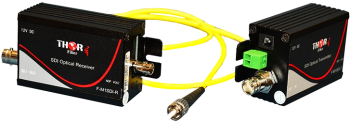SDI (Serial Digital Interface) is a widely used video transmission standard, and various formats exist to accommodate different resolutions and bandwidth requirements. Here are some common SDI formats:
-
SD-SDI (Standard Definition SDI): This format supports resolutions up to 720x576 pixels and is commonly used for standard-definition video.
-
HD-SDI (High Definition SDI): HD-SDI supports resolutions up to 1920x1080 pixels, making it suitable for high-definition video transmission.
-
3G-SDI (3 Gbps SDI): This format allows for higher data rates, supporting resolutions up to 1920x1080 at 60 frames per second.
-
12G-SDI (12 Gbps SDI): Designed for ultra-high-definition video, 12G-SDI supports resolutions up to 3840x2160 at 60 frames per second.
Losses over Coax with Distance: As SDI signals travel over coaxial cables, they can experience signal losses with increasing distance. Higher SDI formats generally require higher-quality cables to mitigate signal degradation. Losses can result in reduced signal quality, affecting video resolution and clarity. Repeaters or signal boosters may be required for longer cable runs to maintain signal integrity.
Advantages of Using Single Mode Fiber for SDI: When transmitting SDI signals over longer distances or in environments with electromagnetic interference, using single mode fiber optic cables offers several advantages:
-
Greater Distance Capability: Single mode fiber can transmit SDI signals over much longer distances without significant signal degradation compared to coaxial cables.
-
Immunity to EMI: Fiber optics are not susceptible to electromagnetic interference, ensuring a stable SDI signal even in electrically noisy environments.
-
Lightweight and Compact: Fiber optic cables are lightweight and more compact than their coaxial counterparts, simplifying installation and cable management.
-
Future-Proofing: Fiber optic technology supports higher data rates, making it suitable for evolving SDI standards and future advancements.
SDI over Fiber with Thor Transmitter and Receiver (ST/PC Connector): The use of Thor Transmitter and Receiver with ST/PC connectors for SDI over fiber enhances the advantages mentioned above. ST connectors, with their twist-and-turn mechanism similar to BNC, provide:
-
Quick and Secure Connections: The ST connector's mechanism allows for fast and secure connections, similar to the familiar BNC twist-and-lock design.
-
Robustness: The ST connector's design ensures a reliable and robust connection, minimizing the risk of accidental disconnection.
-
Ease of Use: The twist-and-turn mechanism simplifies the installation process, making it user-friendly for technicians and installers.
In summary, utilizing various SDI formats and transitioning to fiber optics, especially with Thor Transmitter and Receiver featuring ST/PC connectors, can significantly enhance video transmission capabilities, ensuring high-quality, reliable, and future-proofed signal delivery.

 ES
ES








